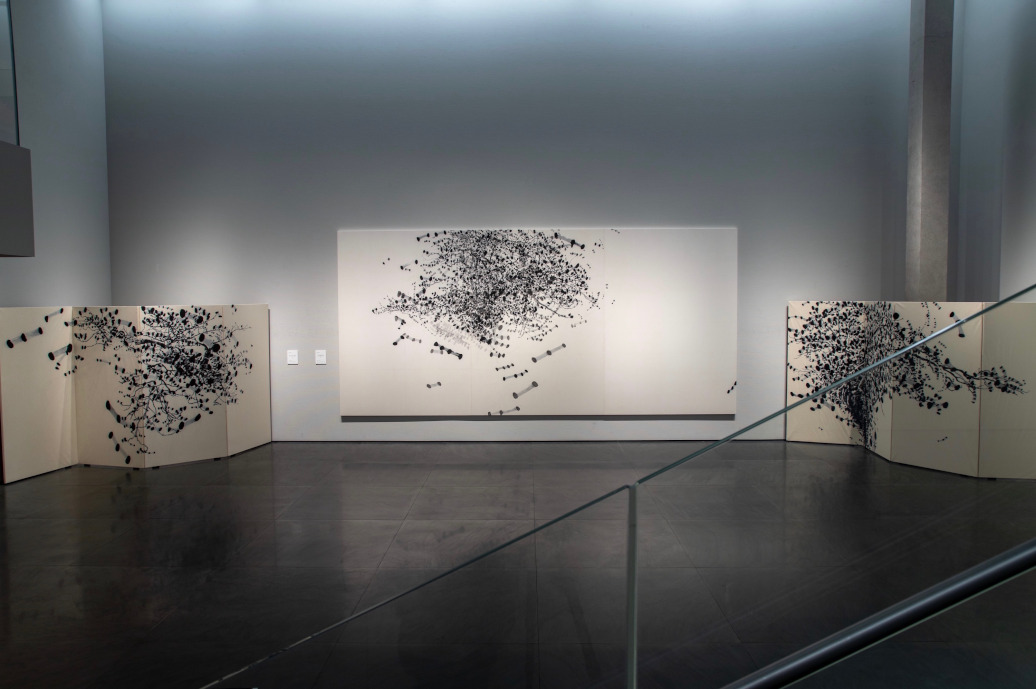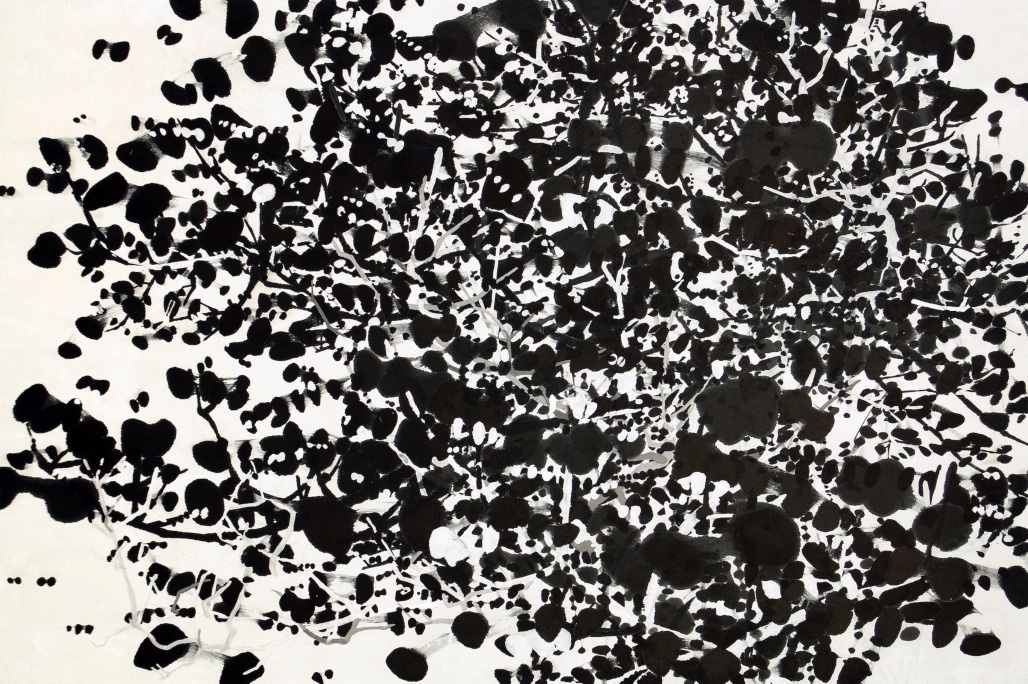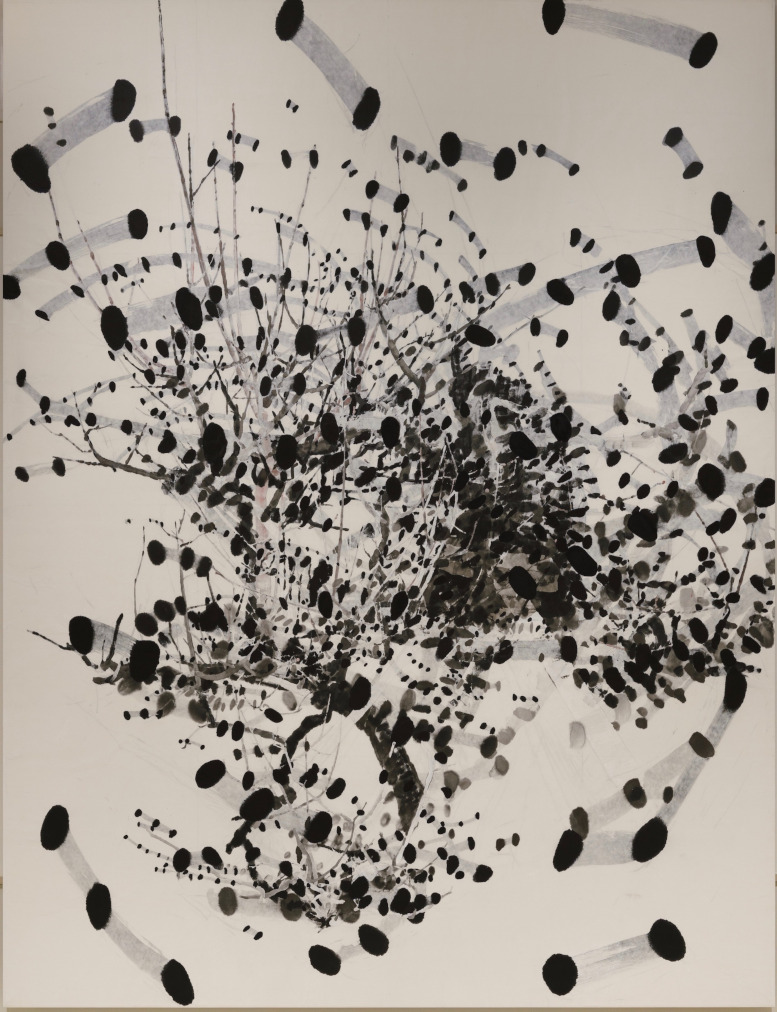浅見貴子 AZAMI Takako

左:《桜の木 1801》 2018年 200×400 cm 四曲一隻 パネルに雲肌麻紙、墨、顔料
中:《桜木影向図》 2015年 265×570 cm パネルに白麻紙、墨、顔料
右:《桜の木 1501》 2015年 200×400 cm 四曲一隻 パネルに雲肌麻紙、墨、顔料
展示風景:「植物の力ー拡大する日本画|岩田壮平 浅見貴子」展 香川県立東山魁夷せとうち美術館 2019年 撮影:宮脇 慎太郎
Left: Cherry Tree 1801, 2018, 200×400 cm, Sumi ink and Pigment on Hemp paper, Ⅿounted on Wooden panel
Center: Manifestation of Cherry Tree, 2015, 265×570 cm, Sumi ink and Pigment on Hemp paper, Ⅿounted on Wooden panel
Right: Cherry Tree 1501, 2015, 200×400 cm, Sumi ink and Pigment on Hemp paper, Ⅿounted on Wooden panel
Installation view: The Power of Plants – The Growing Japanese Painting: IWATA Sohey and AZAMI Takako, Kagawa Prefectural Higashiyama Kaii Setouchi Art Museum, 2019 Photo by MIYAWAKI Shintaro
浅見貴子
AZAMI Takako
1964年埼玉県生まれ。埼玉に在住、活動。
「ざわめく空気が流れる-浅見貴子の幸福と不穏」 小勝禮子
浅見貴子は、雲肌麻紙に岩絵の具、墨による表現を一貫して追求してきた画家である。一時、朱や銀箔に心を惹かれたこともあったが、今は墨の濃淡を基調としたモノクロームの表現に戻っている。1990年代も後半になってから、彼女は深い闇の漆黒から、はかない薄墨の痕跡まで、驚くほど豊かな黒から灰白色にいたる諧調によって、漂い、流れる空気の表現に移行してみせた。(中略)
浅見の画面は、雲肌麻紙という吸湿性のよい和紙に、水に溶いた墨や胡粉でほとんど裏側から筆を置いたもので、最終的に表に返したときに、一番手前に見える墨を滲ませた大きい点は、描いているときは最初に、一番下に置かれた筆致だという。こうした見る者の視覚の逆転からも、浅見の画面の奥行きの深さや、その裏側に入り込めそうな空気感が、絶妙に創り出される。
秩父の豊かな自然の中に育ち、現在も、繁茂する庭の樹木の写生から始める浅見は、制作中の、水に墨が溶けるのを見ているときにも、自分が自然の営みの中に組み込まれていることを感じるという。(中略)
「ただ、この樹と向き合ったときの実感を表わしたかった」「自然はとどまるところなく再生し、進化し続ける」。浅見の述懐だが、その言葉どおり、マツはその生命に始まりも終わりもないかのように、なお伸びやかに野放図に成長を止めない。中心も極点もない、流れるような、またその意味で大胆な画面である。
自然への全幅の信頼と一体感を基底にした伸び伸びとした幸福感とともに、浅見貴子の絵画は伝統的な日本画とはまったく異なる新しさを見せながら、形ばかりの花鳥風月を越えた、アニミズム的な不穏な力を宿している。
「第2回東山魁夷記念日経日本画大賞展」図録、推薦文より一部抜粋、日本経済新聞社、2002年。
浅見貴子「風と光を織り込む」 由本みどり
ニュージャージー・シティー大学准教授/ギャラリー・ディレクター
浅見の、余分な表象をそぎ落とした、自然の本質を追い求めるような絵画は、20世紀前半で言えば、モンドリアンの初期の木を抽象した連作、中頃では、ヘレン・フランケンサーラーによる、キャンバス地に絵の具をスポンジで染み込ませた大型の絵画、後半では、アグネス・マーティンの鉛筆の線で覆われた白いキャンヴァスの連作を想起させる。モンドリアンとマーティンが縦横の線による最も明快な抽象を編み出したのに似て、浅見は、墨の点と線とからなる独特のシステムを築いたし、フランケンサーラーが生のキャンバス地を水で薄めた絵の具で染めていったように、浅見も雲肌麻紙の裏側から表へと墨を浸透させて、豊かな質感をたたえた決して平面的でない、奥行きのある画面を確立させた。従って、水墨画だからといって、単に禅画や中国の水墨画に浅見のルーツを探すのは、短絡的であるだろう。(中略)
こうして、浅見は、日本画も水墨画も、その時々の彼女の感性を捉える手段として、自由に改変を加えながら融合していくことを恐れない。それらの伝統を保持することも重要ではあろうが、彼女は、あくまでも、現代に生きる個人に見合った、新しい表現を生み出すことを選び取る。浅見自身の言葉を借りれば、紙の裏と表の両面から描くことで、「画面を縫う」ような感覚を得た彼女は、そこへ「風と光を織り込む」ことさえできるようになったのだ。
個展カタログ『Takako Azami “Viewing Light”』、2009年、M.Y. Art Prospects (現、MIYAKO YOSHINAGA)、(掲載エッセイに加筆)
Born in Saitama, Japan in 1964. lives and works in Saitama.
Murmurous Air that Flows:The Sense of Happiness and the Disturbing Force in Azami Takako’s Painting
KOKATSU Reiko, Art Historian/Art Critic
Azami Takako is a painter who has consistently pursued expressions using mineral pigment and sumi ink on hemp paper. She was attracted to and used vermilion and silver leaf for a time but went back to a monochromatic form of expression that is based around different shades of sumi ink. From the latter half of the 1990s, she made a shift to expressing the drifting and flowing of air. She attained this through gradations, ranging from amazingly rich tones of black to grayish-white—that is, from the jet-black tone emerging in the depth of darkness to the ephemeral traces of light-sumi gray.[….]
For the support of her works, Azami adopts an absorbent hemp paper, on which she applies sumi ink and white pigment diluted with water. In doing so, she mainly places her brush on the backside of the support. When it is ultimately turned over to the front side, one finds at the very fore big dots where the sumi ink bled through, which resulted from the brush being applied at the very bottom (that is, at the earliest stage of her production process). From such a reverse perspective to the viewer, she exquisitely originates a sense of deep depth on the picture plane, allowing one to feel as if it is possible to enter into that backside.
Azami grew up in Chichibu, Saitama Prefecture where nature is abundant. Even today, she begins her work from sketching the luxuriant trees in her garden. Looking at how sumi ink dissolves in water while creating her work makes her feel that she herself is embedded within the workings of nature. [….]
Recollecting on her art and nature, Azami stated: “I just wanted to express the sensation that I actually felt when I gazed at this tree,” and “Nature perpetually reproduces and continually evolves.” True to these words, Azami’s pine trees continue to grow ever more freely and unbridled in her paintings, as if their lives have no beginning or end. Nor do they have a specific center or a climax; rather, they seem to be flowing. In this respect, one can say that they are bold expressions.
Azami Takako’s paintings manifest a sense of spontaneous happiness that is based on her full trust in nature and her feeling of oneness with nature. In addition, they also reveal a newness that is entirely different from the traditional Japanese style of painting, while also inherently possessing an animistic type of disturbing force. This surmounts the “beauties of nature” style of Japanese painting that has been reduced to mere formality.
Excerpt from Kokatsu’s recommendation essay in the 2nd Higashiyama Kaii Memorial Nikkei Nihonga Award (Exh.Cat.), Nihon Keizai Shimbunsha, 2002. (Translated by Nanpei Taeko )
Takako Azami: “Weaving Wind and Light”
YOSHIMOTO Midori , Associate Professor and Gallery Director, New Jersey City University
Azami’s paintings, spare in their representation, have sought the essence of nature in ways that may remind the viewer of an early 20th-century series by Piet Mondrian, in which trees were increasingly abstracted; Helen Frankenthaler’s large canvases, stained with sponges dipped in paint, in the mid-20th century; and Agnes Martin’s series of white paintings covered with intricate pencil lines from the 1960s. Like Mondrian and Martin, both of whom invented their clear-cut abstractions by the use of grid lines, Azami created her own system consisting of dots and lines. Not unlike Frankenthaler, Azami created a non-flat, certain spatial depth with a rich texture in her painting surface by letting the ink saturate from the back of hemp paper to the front. Hence, it would be simplistic to search for her aesthetic roots within the ink painting tradition just because of her medium. [….]
In order to capture her senses’ perceptions at different times, Azami is not afraid of melding nihonga and suibokuga freely into one process and adding renovations to the combination. Although it is important to preserve these separate traditions, she chooses to concoct a new expression, one that suits an individual living in the contemporary world. By inventing a method of painting that involves both sides of paper, she has even obtained, according to her own words, the feeling of “sewing a picture” as if she were “weaving wind and light.”
Exhibition catalog, Takako Azami: Viewing Light, 2009, M.Y. Art Prospects (Formerly known as MIYAKO YOSHINAGA) / (A revision of an essay in the catalog)
更新された最新の情報は、作家や画廊のウェブサイトをご覧ください。
Please refer to the artist’s and the gallery’s website/social media pages for new updates.

《Pine Tree》2008年 パネルに白麻紙、墨、顔料 122×183 cm
Pine Tree, 2008, Sumi ink and Pigment on Hemp paper, Ⅿounted on Wooden panel, 122×183 cm

《梅の木 2001》 2020年 パネルに白麻紙、墨、顔料 265×203 cm
Plum Tree 2001, 2020, Sumi ink and pigment on hemp paper, mounted on wooden panel, 265×203 cm

《gray net 200103》 2020年 パネルに雲肌麻紙、墨、顔料 72.5×91 cm
gray net 200103, 2020, Sumi ink and Pigment on Hemp paper, Ⅿounted on Wooden panel, 72.5×91 cm

